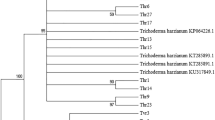Abstract
The potential of antagonist P-2 for controlling postharvest gray mold decay of grape berries and their effects on postharvest quality of fruits was investigated. The results showed that antagonist P-2 at 1 × 108 CFU ml−1 completely inhibited the gray mold decay after 4 days, significantly inhibited the spore germination and lesion diameters of Botrytis cinerea in vitro, reduced the natural decay development of grape berries, and did not impair quality parameters, including TSS (total soluble solids), ascorbic acid, and titratable acidity. Moreover, the results of ITS (internal transcribed spacer) analysis indicated that antagonist P-2 belonged to Hanseniaspora uvarum.


Similar content being viewed by others
References
Adikaram NKB, Joyce DC, Terry LA (2002) Biocontrol activity and induced resistance as a possible mode of action for Aureobasidium pullulans against grey mould of strawberry fruit. Australas Plant Pathol 3:223–229
Barnett JA, Payne RW, Yarrow D (2000) Yeast: characteristics and Identification. Cambridge University Press, Cambridge
Bar-Shimon M, Yehuda H, Cohen L, Weiss B, Kobeshnikov A, Daus A, Goldway M, Wisniewski M, Droby S (2004) Characterization of extracellular lytic enzymes produced by the yeast biocontrol agent Candida oleophila. Curr Genet 3:140–148
Cadez N, Raspor P, De-Cork AWAM, Boekhout T, Smith MTh (2002) Molecular identification and genetic diversity within species of the genera Hanseniaspora and Kloeckera. FEMS Yeast Research 1:279–289
Cao SF, Zheng YH, Tang SS, Wang KT (2008) Improved control of anthracnose rot in loquat fruit by a combination treatment of Pichia membranifaciens with CaCl2. Int J Food Microbiol 126:216–220
Cappellini RA, Ceponis MJ, Lightner GW (1986) Disorders in table grape shipments to the New York market 1972–1984. Plant Dis 70:1075–1079
Droby S, Vinokur V, Weiss B, Cohen L, Daus A, Goldschmidt EE, Porat R (2002) Induction of resistance to Penicillium digitatum in grapefruit by the yeast biocontrol agent Candida oleophila. Phytopathology 92:393–399
Elad Y (1994) Biological control of grape grey mould by Trichoderma harzianum. Crop Prot 13:35–38
Esteve-Zarzoso B, Peris-Toran MJ, Ramon D, Querol A (2001) Molecular characterization of Hanseniaspora species. Antonie Van Leeuwenhoek 1:85–92
Guzev L, Danshin A, Zahavi T, Ovadia A, Lichter A (2008) The effects of cold storage of table grapes, sulphur dioxide and ethanol on species of black Aspergillus producing ochratoxin A. Int J Food Sci Technol 43:1187–1194
Janisiewicz WJ, Korsten L (2002) Biological control of postharvest diseases of fruits. Annu Rev Phytopathol 40:411–441
Larrigaudiere C, Pons J, Torres R, Usall J (2002) Storage performance of clementines treated with hot water, sodium carbonate and sodium bicarbonate dips. J Hortic Sci Biotechnol 77:314–319
Latorre BA (2007) Gray mold (Botrytis cinerea), a limiting factor for table grape production in Chile. Fitopatologia 42:9–20
Long CA, Gao Y (2009) Kloeckera apiculata strain (34-9) to control Botrytis cinerea during the pre-and postharvest handing of strawberries. Ann Microbiol 59(1):77–81
Long CA, Wu Z, Deng BX (2005) Biological control of Penicillium italicum of citrus and Botrytis cinerea of grape by strain 34-9 of Kloeckera apiculata. Eur Food Res Technol 221:197–201
Peng G, Sutton JC (1990) Biological methods to control grey mould of strawberry. Pest Dis 3:233–240
Ragsdale NN, Sisler HD (1994) Social and political implications of managing plant diseases with decreased availability of fungicides in the United States. Annu Rev Phytopathol 32:545–557
Saligkarias ID, Gravanis FT, Epton HAS (2002) Biological control of Botrytis cinerea on tomato plants by the use of epiphytic yeasts Candida guilliermondii strains 101 and US 7 and Candida oleophila strain I-182: in vivo studies. Biol Control 2:143–150
Smilanick JL (2004) Postharvest diseases of fruits and vegetables: development and control. Postharvest Biol Technol 31:213–214
Smilanick JL, Hartsell PI, Henson DC (1990) Factors influencing sulfite residues in table grape after dioxide fumigation. Am J Enol Vitic 2:131–136
Sujatha P, Raju KWSNB, Ramana T (2005) Studies on a new marine streptomycete BT-408 producing polyketide antibiotic SBR-22 effective against methicillin resistant Staphylococcus aureus. Microbiol Res 2:119–126
Taguchi Y, Hyakumachi M, Tsueda H, Kawane F (2003) Method for adhering Bacillus subtilis IK-1080 to bumblebees and control of gray mold disease of tomato. Jpn J Phytopathol 2:94–101
Wilson CL, Chalutz E (1989) Postharvest biological control of Penicillium rots of citrus with antagonistic yeasts and bacteria. Sci Hortic 40:105–112
Wright KP, Kader AA (1997) Effect of controlled-atmosphere storage on the quality and carotenoid content of sliced persimmons and peaches. Postharvest Biol Technol 10:89–97
Yang LY, Huang HP, Tang FR, Hu MJ, Zhang SQ, Huang JS (2006) Rapid molecular identification and detection of Colletotrichum musae with species-specific primers based on the internal transcribes spacer (ITS) region. Acta Phytopathol Sin 36:219–225 (In Chinese)
Yu T, Zhang HY, Li XL, Zheng XD (2008) Biocontrol of Botrytis cinerea in apple fruit by Cryptococcus laurentii and indole-3-acetic acid. Biol Control 2:171–177
Zhang H, Zheng X, Fu C, Xi Y (2005) Postharvest biological control gray mold rot of pear with Cryptococcus laurentii. Postharvest Biol Technol 35:79–86
Zhang HY, Ma LC, Wang L, Jiang S, Dong Y, Zheng XD (2008a) Biocontrol of gray mold decay in peach fruit by integration of antagonistic yeast with salicylic acid and their effects on postharvest quality parameters. Biol Control 1:60–65
Zhang HY, Wang L, Dong Y, Jiang S, Zhang HH, Zheng XD (2008b) Control of postharvest pear diseases using Rhodotorula glutinis and its effects on postharvest quality parameters. Int J Food Microbiol 126:167–171
Acknowledgement
The research was supported by Innovative Research Team of National Natural Science Foundation of China(30921002).
Author information
Authors and Affiliations
Corresponding author
Rights and permissions
About this article
Cite this article
Liu, H.M., Guo, J.H., Cheng, Y.J. et al. Control of gray mold of grape by Hanseniaspora uvarum and its effects on postharvest quality parameters. Ann Microbiol 60, 31–35 (2010). https://doi.org/10.1007/s13213-010-0018-3
Received:
Accepted:
Published:
Issue Date:
DOI: https://doi.org/10.1007/s13213-010-0018-3




